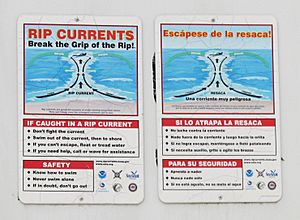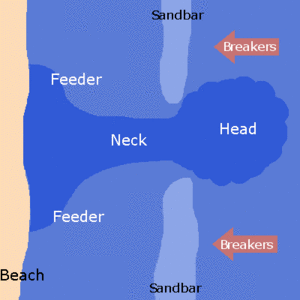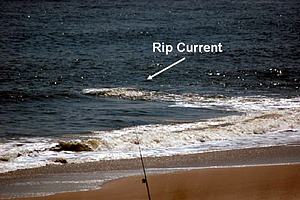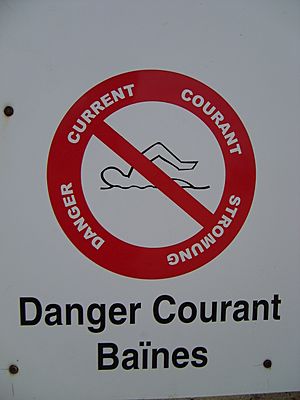Rip current facts for kids
A rip current is a strong, narrow stream of water that flows away from the shore at beaches where waves are breaking. Imagine it like a fast-moving river flowing out to sea, cutting through the incoming waves. The current is strongest and fastest right at the water's surface.
Rip currents can be very dangerous for people in the water. Swimmers caught in a rip current might not understand what is happening. They might panic or get very tired trying to swim against the strong flow. Because of this, rip currents are the main reason lifeguards rescue people at beaches. In the United States, they cause about 71 deaths by drowning each year as of 2022[update].
A rip current is not the same as undertow, even though some people use the words incorrectly. Neither a rip current nor an undertow can pull you down and hold you underwater. A rip current simply carries floating things, including people, out past the breaking waves. Once it's past the waves, the current loses its power and releases whatever it's carrying.
Contents
How Rip Currents Form
Rip currents form when wind and breaking waves push a lot of water towards the land. This makes the water level slightly higher along the shore. This extra water then tries to flow back to the open ocean through the easiest path. If there's a slightly deeper area, like a gap in an offshore sandbar or reef, water can flow out more easily there. This starts a rip current through that gap.
Water that piles up near the beach flows along the shore towards the rip current. These are called "feeder currents." The extra water then rushes out at a right angle to the beach. This narrow, fast-moving part is called the "neck" of the rip. This is where the current is fastest. When the rip current reaches beyond the breaking waves, it spreads out, slows down, and disappears. This wider, weaker area is called the "head" of the rip.
Rip currents can form along the coasts of oceans, seas, and even large lakes if the waves are strong enough. They often happen on gently sloping beaches, especially where waves hit the shore straight on. They also form where the underwater ground makes it easy for water to flow out in one spot. It can be hard to guess exactly where rip currents will appear. Some always show up in the same places, but others can suddenly appear and disappear along the beach. This depends on the shape of the ocean floor and the direction of the waves.
Rip currents are usually quite narrow. However, they tend to be more common, wider, and faster when the breaking waves are large and powerful. The shape of the ocean floor near the shore makes some beaches more likely to have rip currents. A few beaches are well-known for having many rip currents.
Even though "rip tide" is a wrong name, in places with big differences between high and low tide, rip currents might only happen at certain times. This is when the water is shallow enough for waves to break over a sandbar, but deep enough for the broken waves to flow over it.
A common misunderstanding is that rip currents can pull a swimmer under the water. This is not true. In fact, a rip current is strongest near the surface. The flow near the bottom is slowed down by friction with the seabed.
The surface of a rip current can sometimes look calm and smooth, without any breaking waves. This can trick beach-goers into thinking it's a safe place to swim.
Spotting a Rip Current
Rip currents have a special look, and with some practice, you can often see them from the shore before you get in the water. This helps lifeguards, swimmers, surfers, and others avoid them. Sometimes, experienced water users even use them to get out past the waves quickly.
Rip currents often look like a road or river flowing straight out to sea. They are easiest to spot when you look down at the breaking waves from a higher spot. Here are some things to look for:
- A break in the waves: The water in the rip often looks flat, unlike the lines of breaking waves on either side of it.
- A "river" of foam: The surface of the rip might look foamy because the current is carrying foam from the waves out to open water.
- Different color: The rip might be a different color than the water around it. It's often cloudier or muddier. So, depending on the sun, it might look darker or lighter.
- Moving objects: You might see foam or floating trash moving away from the shore in the rip. In the areas around it, floating things are usually being pushed towards the shore by the waves.
Learning these signs can help you recognize where rip currents are before you enter the water.
In the United States, some beaches have signs from the National Oceanic and Atmospheric Administration (NOAA) and the United States Lifesaving Association. These signs explain what a rip current is and how to escape one. They are titled, "Rip Currents; Break the Grip of the Rip." You can see two of these signs in the image at the top of this article. Also, you can always ask lifeguards for information. They are always watching for rip currents and will move their safety flags to help swimmers avoid them.
Danger to Swimmers
Rip currents are a big danger for people in shallow water with breaking waves, whether in seas, oceans, or large lakes. They cause about 80% of all rescues done by beach lifeguards.
Rip currents usually flow at about 0.5 meters per second (1.6 feet per second). But they can be as fast as 2.5 meters per second (8.2 feet per second), which is faster than any human can swim. Most rip currents are quite narrow. Swimmers can usually get out of the rip easily by swimming sideways, parallel to the beach. Swimmers who don't know this might get very tired trying to swim straight back to shore against the strong current. The current completely disappears at the "head" of the rip, outside the breaking waves. So, there's a limit to how far out to sea a rip current will take you.
People drown in a rip current when they don't have good swimming skills and panic. Or, they might keep trying to swim to shore against a very strong rip current, get completely exhausted, and then drown.
According to NOAA, rip currents caused an average of 71 deaths each year in the United States over the ten years leading up to 2022. In 2022 alone, there were 69 deaths. A study from Australia in 2013 found that rip currents killed more people there than bushfires, floods, cyclones, and shark attacks combined.
How to Survive a Rip Current
If you get caught in a rip current, you might notice you are moving away from the shore very quickly. It's usually not possible to swim directly back to shore against a rip current, so this is not recommended. Remember, a rip current does not pull you under the water. It just carries you away from the shore in a narrow band of moving water.
A rip current is like a moving treadmill. You can get off it quite easily by swimming sideways, across the current, parallel to the shore in either direction. Rip currents are usually not very wide, so getting out of one only takes a few strokes. Once you are out of the rip current, getting back to shore is not hard. This is because waves will be breaking, and they will push floating things, including swimmers, towards the shore.
Another option is to simply relax, either floating or treading water. Let the current carry you until it completely disappears beyond the surf line. Then, you can signal for help, or swim back through the waves. When swimming back, do it diagonally, away from where the rip was, and towards the shore.
It's very important for anyone swimming at the coast to understand the danger of rip currents. Learn how to spot them and how to deal with them. And whenever possible, only swim in areas where lifeguards are on duty.
Uses of Rip Currents
Experienced water users, like surfers, bodyboarders, divers, surf lifesavers, and kayakers, sometimes use rip currents. If they want to get out past the breaking waves quickly, a rip current can be a fast and easy way to travel.
See also
 In Spanish: Corriente de resaca para niños
In Spanish: Corriente de resaca para niños
- Cross sea
- Longshore drift
- Rip current statement – warnings issued by the U.S. National Weather Service
- Undertow (water waves)
- Rip tide






